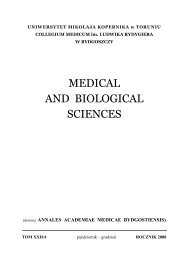Medical and Biological Sciences XXVI/2 - Collegium Medicum ...
Medical and Biological Sciences XXVI/2 - Collegium Medicum ...
Medical and Biological Sciences XXVI/2 - Collegium Medicum ...
Create successful ePaper yourself
Turn your PDF publications into a flip-book with our unique Google optimized e-Paper software.
Value of erythrocyte sedimentation rate, C-reactive protein <strong>and</strong> procalcitonin concentration versus multimarker strategy... 13<br />
To get the homogeneous group of patients, the<br />
children with the presence of bronchial asthma, cystic<br />
fibrosis, pulmonary bronchodysplasts, congenital heart<br />
diseases, abnormalities of chest <strong>and</strong> lungs, children<br />
treated with bronchodilatators <strong>and</strong> anti-inflammatory<br />
drugs, children with gastroesophageal reflux were<br />
excluded from the study. The agreement of parent(s)<br />
for participation in the study was obligatory.<br />
According to the results of physical examination in<br />
pediatric emergency department <strong>and</strong> during first two<br />
days of hospitalization at the pediatric department,<br />
children were included into one of two subgroups:<br />
children with clinical presentation of viral infection<br />
(group A) <strong>and</strong> children with respiratory tract bacterial<br />
co-infection (group B). In the study group of children<br />
the concentrations of CRP, PCT <strong>and</strong> ESR were<br />
analyzed. Additionally, in the suspicion of bacterial<br />
infection, in some cases, according to the results of<br />
physician examination chest X ray (CXR) was<br />
performed. To classify a child into the group A the<br />
chest X-ray (if performed) had to be without<br />
inflammatory changes but the presence of peripheral<br />
oedema or atelectasis should be present. The CXR<br />
examination was performed in 130 children in total.<br />
WBC count of 12 M/L or more in the presence of<br />
clinical symptoms suggested possibility of bacterial coinfection<br />
[5,9,10]. Characteristics of the whole group<br />
of children with bronchiolitis <strong>and</strong> subgroups A <strong>and</strong> B<br />
are presented in Table I.<br />
Table I. Age <strong>and</strong> sex of children hospitalized because of<br />
bronchiolitis<br />
Number of<br />
children<br />
Sex<br />
Age [months]<br />
Age ♂ [months]<br />
Age ♀ [months]<br />
Total Group A Group B<br />
149 (100%)<br />
♂ 102<br />
(68.5%)<br />
♀ 47<br />
(31.5%)<br />
7 (1-24)<br />
6,5 (1-24)<br />
10 (1-24)<br />
91 (61.1%) 58 (38.9%)<br />
p=0,0003<br />
♂ 62<br />
(68.1%)<br />
♀ 29<br />
(31,9%)<br />
p=0,0001<br />
♂ 40<br />
(69,0%)<br />
♀ 18<br />
(31%)<br />
8 (1-24) 5 (1-24)<br />
p=0.001<br />
7 (1-24) 5 (1-24)<br />
p=0.0043<br />
11 (1-24) 6 (1-24)<br />
p=0.0559<br />
♂ - boys, ♀ - girls<br />
Presented data are median <strong>and</strong> (minimal – maximal values).<br />
Statistical significance was calculated for data in group A <strong>and</strong> B.<br />
Etiology was identified with the Directigen RSV<br />
test kit (RSV detection set) (Becton-Dickinson) <strong>and</strong><br />
Euroimmun Pneumo – FIDE M (RTP1) (Lencomm),<br />
detecting viruses such as RS virus, adenovirus,<br />
influenza <strong>and</strong> parainfluenza viruses <strong>and</strong> bacterial<br />
pathogens such as Bordetella, Mycoplasma, Legionella<br />
<strong>and</strong> Chlamydia. [5,11,13,14]. We found respiratory<br />
syncytial virus in 3 cases, in 1 case - adenovirus<br />
infection, in 8 cases - mycoplasma pneumoniae<br />
infection <strong>and</strong> in 4 - Bordetella pertusis infection.<br />
In the study group of children the concentrations of<br />
inflammatory biomarkers such as CRP, PCT <strong>and</strong> ESR<br />
were analyzed. CRP was assayed in the serum using<br />
high-sensitivity assay (BN II Dade Behring). The assay<br />
detection limit is 0.15 mg/L <strong>and</strong> CV is 5% for<br />
concentration of 0.35 <strong>and</strong> 0.5 mg/L. PCT was assayed<br />
using chemiluminescent immunoassay (Liaison-Byk),<br />
ESR was measured with Sedisystem (Becton-<br />
Dickinson).<br />
Border line values suggesting the presence of<br />
bacterial infection were: for ESR – 15mm/h, CRP 15<br />
mg/L <strong>and</strong> PCT 1.0 ng/ml [5,6,7,9,10].<br />
Study was approved by the Ethics Committee of the<br />
<strong>Collegium</strong> <strong>Medicum</strong> of Nicolaus Copernicus<br />
University.<br />
STATISTICAL METHODS<br />
Calculations were performed using Statistica PL<br />
6.0 <strong>and</strong> Analyse-it for Microsoft Excel (version 2.12)<br />
[15].<br />
Quantitative data from patients of groups A <strong>and</strong> B,<br />
after confirmation of normal distribution, were<br />
compared using Student’s T test, whereas qualitative<br />
parameters were compared with χ 2 test with Yaets<br />
correction when necessary.<br />
Receiver operating curves (ROC) analysis was used<br />
to define the value of CRP, PCT <strong>and</strong> ESR better in the<br />
distinguishing viral from viral coexisting with bacterial<br />
infection. The area under the curve calculated for CRP<br />
PCT <strong>and</strong> ESR alone <strong>and</strong> in different combination was<br />
compared using two-tailed Student’s t test.<br />
RESULTS<br />
Mean ESR in the study group was 14.1 ± 20.4<br />
mm/1h. Mean CRP concentration was 4.94 ± 4.92<br />
mg/L <strong>and</strong> PCT concentration was 0.48 ± 1.50 ng/ml.<br />
Mean ESR was 7.5 ± 5.4 mm/1h in the group A <strong>and</strong><br />
significantly higher in the group B 25.5 ± 27.5 mm/1h<br />
(p

















